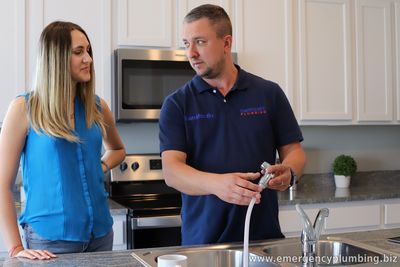Signs That It's Time to Replace Your Kitchen Faucet |
Your kitchen faucet is a vital component of your daily routine, and it plays a significant role in the functionality and aesthetics of your kitchen. While a well-maintained faucet can last for years, there are certain signs that indicate it might be time to consider a replacement. In this post, we'll explore the key indicators that suggest you need a new kitchen faucet.
1. Frequent Leaks: One of the most obvious signs that your kitchen faucet needs replacement is frequent leaks. If you find yourself constantly tightening or repairing the faucet to stop leaks, it's a clear signal that the faucet has reached the end of its lifespan. Leaks not only waste water but can also cause damage to your sink and cabinet. 2. Reduced Water Flow: Over time, mineral deposits and sediments can build up within the faucet, causing a decrease in water flow. If you notice that your faucet's stream is weak or uneven, despite cleaning the aerator, it may be time for a replacement. Newer models often come with better flow rates and more efficient water-saving features.
3. Corrosion and Rust: Examine your faucet for signs of corrosion or rust. These are not only unsightly but can also compromise the quality of your water and pose health risks. If you see any visible corrosion, especially around the base or spout, it's a strong indication that your faucet needs replacing.
4. Difficulty in Temperature Control: Older faucets may struggle with maintaining a consistent water temperature. If you find it challenging to control the hot and cold water balance, it can be frustrating and even potentially dangerous. Upgrading to a modern faucet with precise temperature control can make a significant difference.
5. Outdated Design and Style: Sometimes, the need for a new kitchen faucet is not solely based on functionality but also aesthetics. If your faucet's design is outdated and no longer complements your kitchen's decor, replacing it with a more stylish and contemporary model can breathe new life into your space.
6. Worn Out or Broken Parts: If you've had your faucet for many years and essential parts like handles, sprayers, or the spout have become worn out or broken, it's often more cost-effective to invest in a new faucet than to continually replace individual components.
.A new kitchen faucet can enhance both the efficiency and the appearance of your kitchen, making it a worthwhile investment for any homeowner.
**Contact Emergency Plumbing Today:** Your water heater stopped producing hot water, your water heater is leaking, lavatory or kitchen faucets are leaking, toilet continuously running, garbage disposal not working, drain clogged - that are all our expertise. We service local communities in Highland Park, Glencoe, Lake Forest and Lake Bluff, Deerfield, Glenview, Winnetka, Wilmette, Northbrook, Buffalo Grove and Wheeling, Lake Zurich and Barrington.
|


Comments
Post a Comment